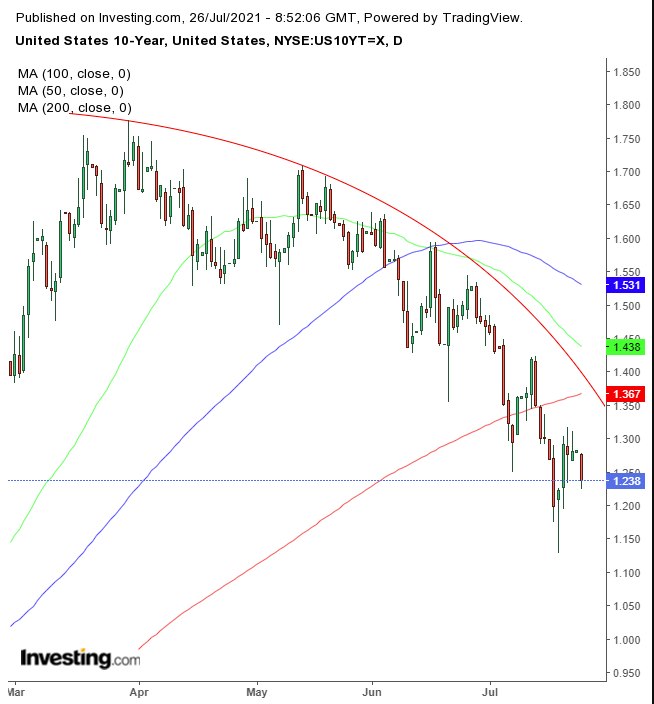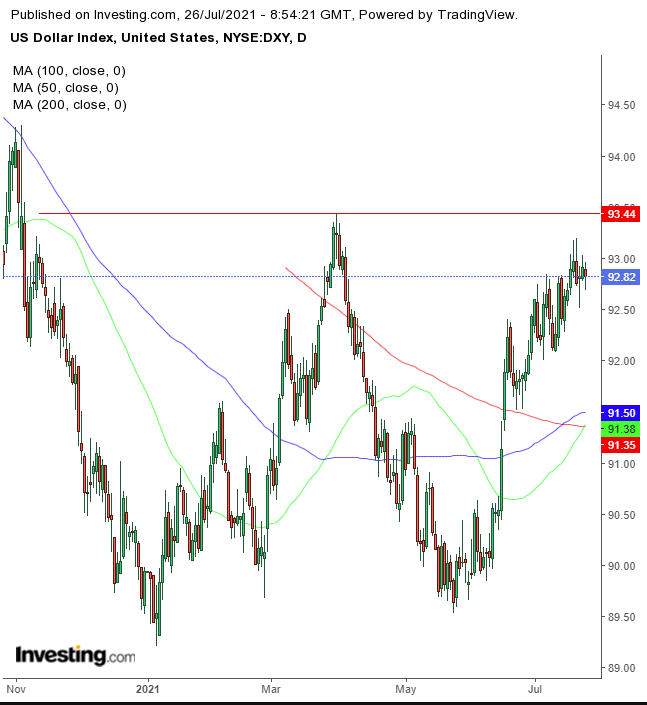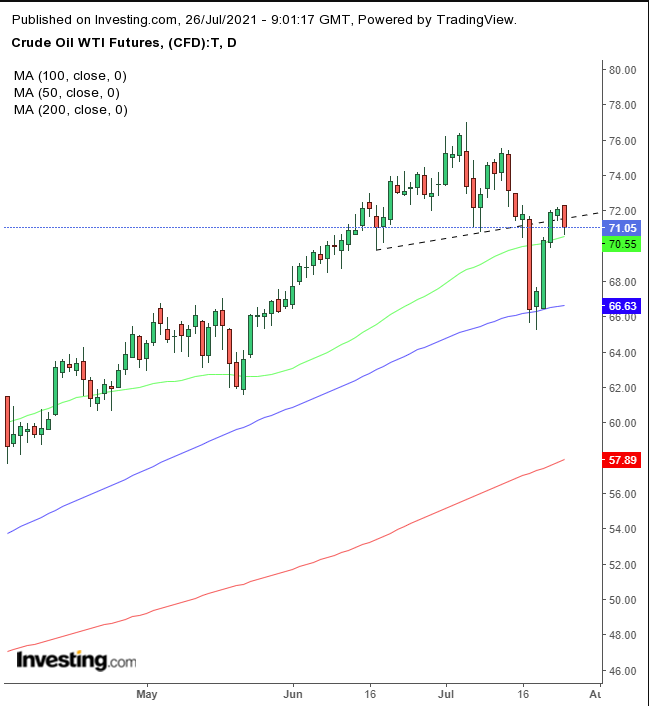- China hits education technology sector with new regulations
- Busiest US earnings week and Fed interest rate decision on tap
- Bitcoin surges to near $40,000
- US durable goods figures are published on Tuesday.
- US initial jobless claims are printed on Thursday.
- On Thursday, US GDP figures are released.
- The FTSE 100 declined 0.2%
- The STOXX 600 fell 0.4%
- Futures on the S&P 500 fell 0.4%
- Futures on the NASDAQ 100 fell 0.2%
- Futures on the Dow Jones Industrial Average fell 0.6%
- The MSCI Asia Pacific Index fell 1%
- The MSCI Emerging Markets Index fell 2.1%
- The Dollar Index was little changed
- The British pound rose 0.2% to $1.3769
- The euro was little changed at $1.1779
- The Japanese yen rose 0.3% to 110.25 per dollar
- The offshore yuan fell 0.1% to 6.4855 per dollar
- The yield on 10-year Treasuries declined four basis points to 1.23%
- Britain’s 10-year yield declined three basis points to 0.55%
- Germany’s 10-year yield declined two basis points to -0.44%
- Brent crude fell 1.2% to $73.21 a barrel
- Spot gold rose 0.4% to $1,809.18 an ounce
Key Events
A global selloff after China tightened regulations in the local for-profit education technology sector was exacerbated by the rise of global COVID cases, pushing futures lower on the Dow, S&P, NASDAQ and Russell 2000 in pre-US open trading on Monday. This week will also be the busiest earnings week in the US market, plus on Wednesday the Fed is set to release its interest rate decision.
Oil continued to weaken as markets are concerned about future demand. Yields continue dropping.
Global Financial Affairs
A glance at US futures paints a clear picture of market sentiment. Both value and growth stocks are down, suggesting traders on both sides of the reflation trade are pessimistic.
In Europe, the STOXX 600 Index was lower as a direct results of China's latest crackdown, as well as the ongoing spread of the coronavirus across the globe. Prosus (AS:PRX), the Dutch technology investor that owns 28.9% of Chinese internet mammoth Tencent (HK:0700) plummeted 8.5% as China’s clampdown on the tech industry intensified.
Automobile makers—a victim of the stay-at-home environment—were under pressure. Porsche (F:PSHG_p) declined 4.5% as the stock turned ex-dividend and Faurecia (PA:EPED), the French car parts producer, slid 4.3%, even though the company increased its 2021 net cash flow target.
The one bright spot in the travel sector was Ryanair (LON:RYA), Europe’s largest low-cost carrier, which topped the pan-European index with a 4% jump, after it raised its sales outlook on strong summer bookings.
China’s regulatory eye roamed over the country's expanding technology sector, particularly the for-profit education sector that has ballooned into a $100 billion industry as the government of the People's Republic of China said education has been “hijacked by capital."
When markets in the world’s second-largest economy’s sell off, it affects the rest of the world. So indices in Asia declined and European shares followed, taking US futures along for the ride.
In the Asia Pacific region, the increase in cases of COVID in Sydney—which will not be helped by the defiant anti-lockdown protests there—are due in part to the low vaccination rate in the country. But global cases have also been accelerating, with figures increasing the most in two months due to the Delta strain. The variant is also surging in the US where the top infectious disease expert, Anthony Fauci warned the country is “moving in the wrong direction,” with not even half of America’s population fully vaccinated.
At the Olympic Games in Tokyo the news on the virus is growing worse, further dampening morale, so much so that some are asking, “will we ever be able to travel with young kids?” Despite this, the Nikkei 225 was the only regional index in the green, more than a percentage point higher. Hong Kong’s Hang Seng plunged 3.9% on a panicked selloff after the news from China.
Against this backdrop, we are about to see the busiest earnings week in the quarter, with big names including the likes of Tesla (NASDAQ:TSLA), Apple (NASDAQ:AAPL) and Microsoft (NASDAQ:MSFT). Investors will also be closely examining the fine details and language of the Federal Reserves interest rate decision.
Yields on the 10-year Treasury note, which surged in the first half of the year, have resumed their decline.

Rates will test the powerful hammer of June 20, after falling below the 200 DMA, pulling down the 50 DMA to a possible Death Cross. Meanwhile, the 50- and 100-week MAs are joining forces to support last Tuesday’s hammer.
The dollar followed yields lower.

Just after the 50 DMA crossed over the 200 DMA, it triggered a Golden Cross, ahead of a potential double-bottom completion.
The dollar emboldened gold bulls, pushing the yellow metal to its highest in a week, having found support by the 100 DMA.
However, we consider this rise to be temporary, after having completed a bearish wedge.
Bitcoin surged as much as 12.1%, the most since June 9.
The digital coin neared $40,000 for the first time since mid-June, adding $114 billion to the cryptocurrency's market cap. Market chatter claims the move came amid short covering over speculation that Amazon (NASDAQ:AMZN) will start accepting the cryptocurrency. The move broke our last trade wide open
Oil continued its selloff as the Delta strain once again clouded the demand outlook.

The resistance by the neckline of a small H&S top suggests perhaps the recent leg down was the first of what may be a second, though the trend remains higher.
